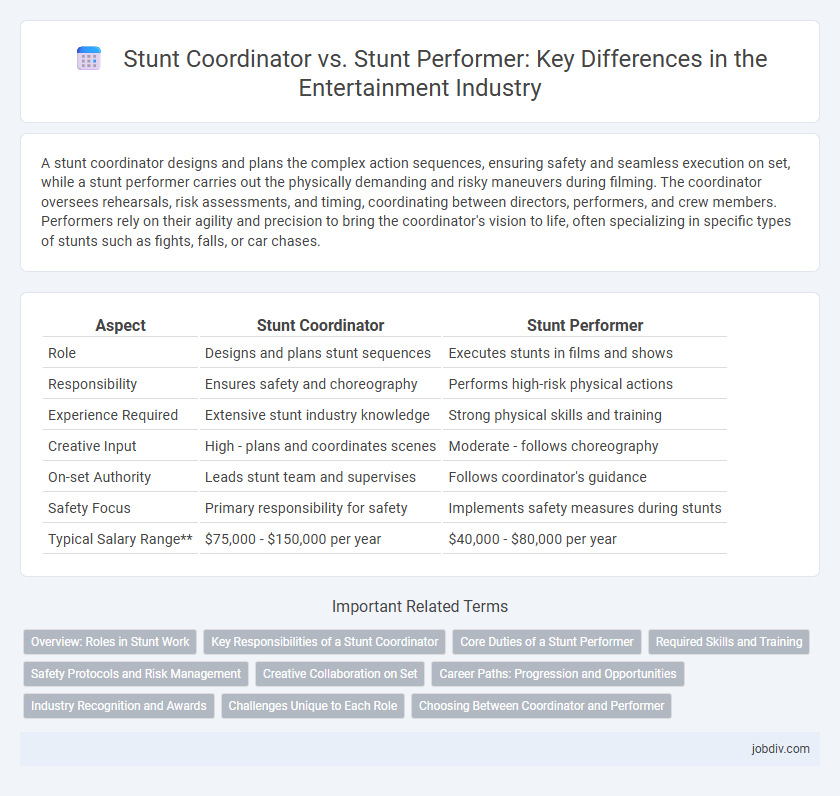A stunt coordinator designs and plans the complex action sequences, ensuring safety and seamless execution on set, while a stunt performer carries out the physically demanding and risky maneuvers during filming. The coordinator oversees rehearsals, risk assessments, and timing, coordinating between directors, performers, and crew members. Performers rely on their agility and precision to bring the coordinator's vision to life, often specializing in specific types of stunts such as fights, falls, or car chases.
Table of Comparison
| Aspect | Stunt Coordinator | Stunt Performer |
|---|---|---|
| Role | Designs and plans stunt sequences | Executes stunts in films and shows |
| Responsibility | Ensures safety and choreography | Performs high-risk physical actions |
| Experience Required | Extensive stunt industry knowledge | Strong physical skills and training |
| Creative Input | High - plans and coordinates scenes | Moderate - follows choreography |
| On-set Authority | Leads stunt team and supervises | Follows coordinator's guidance |
| Safety Focus | Primary responsibility for safety | Implements safety measures during stunts |
| Typical Salary Range | $75,000 - $150,000 per year | $40,000 - $80,000 per year |
Overview: Roles in Stunt Work
A Stunt Coordinator designs and manages complex action sequences, ensuring safety and seamless integration with the production's vision, while the Stunt Performer executes these physically demanding stunts on set. Coordination involves risk assessment, choreography, and collaboration with directors, whereas performers focus on precision and skill to bring dynamic scenes to life. Both roles are essential for crafting authentic, thrilling entertainment experiences in film and television projects.
Key Responsibilities of a Stunt Coordinator
A Stunt Coordinator is responsible for designing, choreographing, and overseeing all stunt sequences to ensure safety and creative execution on set. They collaborate with directors, performers, and stunt teams to plan stunts that align with the production's vision while managing risk through rigorous safety protocols. Their role includes casting stunt performers, arranging rehearsals, and coordinating logistics to seamlessly integrate stunts into the final production.
Core Duties of a Stunt Performer
A stunt performer executes high-risk physical feats such as fight scenes, falls, and vehicle maneuvers to ensure realistic and safe action sequences in films and television. Their core duties include mastering precise movements, maintaining physical fitness, and adhering strictly to safety protocols while performing dangerous stunts. Stunt performers work closely with stunt coordinators to translate choreography into dynamic on-screen action without compromising safety or performance quality.
Required Skills and Training
Stunt Coordinators require extensive experience in choreography, risk assessment, and safety protocols, often holding certifications in stunt driving, fight choreography, and rigging. Stunt Performers must possess physical agility, precision, and specialized training in martial arts, gymnastics, or high falls to execute complex and high-risk scenes effectively. Both roles demand rigorous physical conditioning and continuous skill development, but Coordinators emphasize planning and oversight while Performers focus on execution and performance.
Safety Protocols and Risk Management
Stunt Coordinators design and oversee safety protocols to minimize risks, ensuring all stunts comply with industry regulations and insurance requirements. Stunt Performers execute the physical actions while adhering strictly to these established safety measures to prevent injury. Both roles require thorough training in risk assessment and emergency response to maintain on-set safety standards.
Creative Collaboration on Set
Stunt coordinators and stunt performers engage in dynamic creative collaboration on set to design and execute complex action sequences. Coordinators develop detailed choreography and safety protocols while performers bring these visions to life with precision and physical skill. Their synergy ensures both the artistic impact and safety of high-risk stunts in film and television productions.
Career Paths: Progression and Opportunities
Stunt coordinators oversee the design and execution of complex stunt sequences, often advancing from experienced stunt performers who demonstrate leadership and safety expertise. Career progression typically involves gaining substantial on-set experience and building trust with directors and production teams, opening opportunities for higher-budget and more technically demanding projects. While stunt performers focus on executing physical feats, stunt coordinators expand their roles into choreography, risk assessment, and team management, leading to broader industry recognition and creative input.
Industry Recognition and Awards
Stunt Coordinators receive industry recognition for their expertise in designing and safely executing complex action sequences, often earning awards like the Taurus World Stunt Awards for Best Stunt Coordination. Stunt Performers gain acclaim for their physical skill and bravery, with nominations and wins in categories such as Best Stunt Performance at the Screen Actors Guild Awards. Both roles contribute critically to film and television, yet the coordinator's strategic oversight is particularly celebrated in prestigious stunt-specific accolades.
Challenges Unique to Each Role
Stunt coordinators face the challenge of designing safe yet visually impressive sequences, requiring extensive knowledge of physics, safety protocols, and collaboration with directors. Stunt performers must execute these complex maneuvers flawlessly under high-risk conditions, demanding exceptional physical conditioning, precision, and quick reflexes. Each role requires a unique blend of creativity and technical skill to ensure both spectacle and safety on set.
Choosing Between Coordinator and Performer
Choosing between a stunt coordinator and a stunt performer depends on the specific needs of a film or television production. Stunt coordinators oversee the design, planning, and safety of complex stunt sequences, ensuring all actions align with the director's vision and comply with industry safety standards. Stunt performers execute these high-risk physical actions on set, requiring specialized skills and physical conditioning to bring intense scenes to life.
Stunt Coordinator vs Stunt Performer Infographic

 jobdiv.com
jobdiv.com